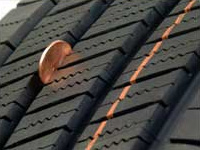
Vehicle Tire Buyer's Guide
Things to Know Before You Go to the Dealer When To Buy
All tires wear out eventually and damage unfortunately happens. The important thing is to quickly determine if your tires are safe to drive on, in need of service, or need to be replaced. Here are some simple ways to tell if you need to buy new tires:
Your Tire Is Damaged
There is a good chance that your tire can be repaired if:
1. The tire has not been driven on when flat
2. The damage is only on the tread section of your tire
3. The puncture is less than 1/4 inch
Have an authorized tire dealer or mechanic remove the tire from the wheel and inspect the tire from the inside. This inspection is absolutely necessary because internal damage is not visible while the tire is mounted.
The proper way to have a tire repaired is to patch the tire from the inside. If you are offered a plug repair — refuse! Plug repairs do not involve taking the tire off the wheel for a proper inspection. A plug is simply inserted into the punctured area. Plug repairs are not reliable and can cause the tire to blowout. Insist on a full inspection and patch repair on the inside of the tire.
Your Tire Is Worn
It's a good idea to check your tires once a month for visible damage and excess wear. There are two ways to tell if your tires are worn out:
Look for wear bars
These are narrow bands that appear in the grooves across the tread of the tire. When the wear bars are even with the tread depth, only 2/32-inch of tread remains. If you can see the wear bars, it's time to replace the tire.
The Penny Trick
The other way to tell if the tread is worn out is to place a penny into the shallowest tread groove with Lincoln's head down. If the top of his head remains visible, then the tire should be replaced.
 |
 |
If the tread is worn below 2/32-inch, water cannot
be channeled away from the tread. At high speeds, this can result
in aquaplaning. In addition, traction in snow is also reduced or
eliminated completely.
Your Tire Size
Knowing your tire size can help you save time at the tire dealership and enables you to make an informed tire purchase. Your vehicle's original equipment tire size can be found in your owner's manual or on the tire placard located on the driver's doorjamb, glove box lid, or inside the fuel hatch. You can also check your existing tire's tire designation located on the sidewall.
If you are interested in a size other than your vehicle's original equipment, or are upgrading your wheels, consult your local expert for advice.
Your Tire Type
One of the first questions your dealer will probably ask you is, "What type of tires are you looking for?" Your dealer is referring to categories such as all-season tires, winter tires, etc.
What's most important is that your new tires meet your needs. Before you go to the tire dealer, think about the best and worst conditions you foresee driving in. What performance criteria are you looking for in a tire? For example, is wet traction more important to you than cornering capability on dry roads? The more you can tell your dealer, the better tire you will get for your needs.
Something to remember at the dealer
Your Warranty Booklet & DOT Registration Card
You should receive a warranty booklet and Department of Transportation (DOT) registration card with your purchase of tires. This booklet will give you information on the care and maintenance of your new tires as well as important warranty information
By completing the DOT tire registration card, you can be notified of any product updates.
Install two new tires on the rear axle
If you need to purchase only two new tires, insist that they are installed on your vehicle's rear axle. New tires grip the road better and when the two new tires are mounted on the rear, they will help reduce the potential for your vehicle to fishtail or hydroplane in wet conditions. (Courtesy of Michelin)
|